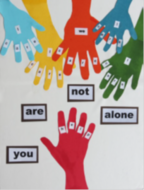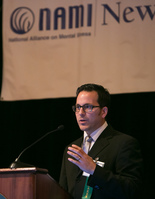GREETINGS

NIMH Director Thomas Insel, MD
It’s that time of year when I like to reflect on what progress has been made in our field over the course of the past 12 months. In my latest blog, I share what I believe to be the most exciting achievements in mental health research for 2014. Topping the list is the RAISE(Recovery After an Initial Schizophrenia Episode) research program. It was a watershed moment when, in the fiscal year (FY) 2014 appropriation bill, Congress set aside funding from the Substance Abuse and Mental Health Services Administration’s (SAMHSA) Community Mental Health Block Grant program for dissemination of evidence-based interventions for first episode psychosis similar to those tested in RAISE. SAMHSA and NIMH are collaborating to take full advantage of this unprecedented opportunity to move research into practice swiftly in contrast to the widely reported 17-year lag in adoption of evidence-based treatments by clinicians. Congress reaffirmed its commitment to this effort with continuation of this set aside in the recently enacted FY 2015 appropriation. We estimate that RAISE-like programs, called Collaborative Specialty Care (CSC), will be available in at least 29 states by October of 2015. While states are beginning to implement these models, or expand upon existing programs, outreach to individuals who experience first episode psychosis will be critical so they know about treatments that can help in the earliest stages of their illness. This issue of Outreach Connection features an example of how Partners are working to make communities aware of the RAISE approach. Your work engaging youth and young adults, families, providers, and other key stakeholders is all the more important now as states’ efforts get underway. The Voices of Recovery video series is a good example of a number of educational resources from the RAISE Connection program that can be used for outreach to the community. NIMH wishes you all the best this holiday season and as always commends you for your efforts to improve the lives of all those affected by mental illness.
|
PARTNER SPOTLIGHT
Outreach Partners inform their communities about the latest NIMH research through social media and other venues.
To highlight suicide prevention research and efforts, NAMI New Hampshire featured Dr. Insel’s Greeting from OPP’s Fall 2014 Outreach Connection in its e-newsletter.

The Pennsylvania Behavioral Health and Aging Coalition postedNIMH research findings on genetic regions linked to schizophrenia in its e-newsletter.


NAMI Virginia created a quarterly research e-newsletter to highlight NIMH-funded research findings and share announcements about studies seeking research participants.
Outreach Partners get NIMH materials and information directly in the hands of community members through a variety of forums.
 |
|
NAMI Indiana used large print and regular print NIMH materials for a training session to senior housing case workers about mental illness and the elderly.
|

The Massachusetts Association of Mental Health distributed NIMH materials at a Summit on Elder Behavioral Health, which brought together a range of stakeholders to dialogue on the challenges serving the growing aging population.
|
The Behavioral Health Education Center of Nebraska providedNIMH materials in Spanish to pre-kindergarten through public high school staff for distribution to educators and families.

The Mental Health Association Oklahoma co-hosted a girls’ and mothers’ conference for the African American community in Tulsa. NIMH resources were distributed to supplement the open discussion on issues facing teen girls, including depression, suicide, and addictions.
|

The University of North Dakota Center for Rural Healthhighlighted the availability of NIMH publications in its e-newsletter.
Outreach Partners conduct outreach projects addressing mental disorders among children and adolescents, or mental health disparities.

Mental Health America of Montana Youth Crisis Diversion Project
Rural and frontier communities in northeast Montana have been significantly impacted by the oil boom of Bakken Oil field in Montana and North Dakota. While the influx of jobs and job-seekers has been a positive for these largely underserved communities, there are also downsides. With stressed infrastructures and families, youth in a psychiatric crisis often end up in a jail or detention setting rather than a nurturing environment focused on utilizing the strengths and resources of the youth, family, and community. In response to this growing challenge, Mental Health America of Montana (MHA of MT) has created the Youth Crisis Diversion Project (YCD) to work directly with law enforcement, youth probation, youth mental health, schools, and other community stakeholders who may determine a youth to be at risk and in need of temporary safe diversion associated with a mental health crisis. Most diversion interventions are six hours to 24 hours in length and involve MHA of MT YCD workers engaging the family and community resources to secure a mental health provider and support services to maintain the youth in the community.
YCD on-going activities in these communities include the development of “safe” local solutions within each county and community; recruitment of staff who have diversity and expertise with families and children who have been involved with the children’s system of care; and collaboration with community stakeholders who are “first responders” to youth in mental health crisis. MHA of MT is collecting data about the youth served by this new project, and an evaluation of YCD is planned to begin next year.
MHA of MT has used NIMH materials and information as part of its outreach and training activities to stakeholders in these communities. For example, recently YCD trainers distributed NIMH publications and showed the Development of the Young Brain video at three law enforcement trainings on children’s mental health, and how to best stabilize and provide safety for youth in crisis.
|
Back to Top
Outreach Partners are informing their communities about NIMH-funded trials actively recruiting participants.

The Mental Health Association in Delaware used content from the NIMH A Participant’s Guide to Mental Health Clinical Research to create a newsletter article about participating in clinical trials.
Mental Health America of California shared an NIMH DIRP announcement about a severe mood dysregulation trial recruiting participants on its Facebook page.

Through its e-newsletter, NAMI Minnesota linked to a list of studies in Minnesota seeking participants on ClinicalTrials.gov.
NAMI New York State’s (NAMI NYS) 2014 Education Conferencefeatured a session by NIMH DIRP staff on the importance of participating in NIMH Clinical Trials. Participants learned the benefits of research participation and the role it plays in understanding and improving care for psychiatric diseases.

Mental Health America of Texas posted study information aboutNIMH DIRP studies currently recruiting in its “Stop Suicide” Daily online news.
Back to Top
Partners provide opportunities for NIMH scientists and grantees to present their findings at local meetings and conferences.
 |
|
NAMI New Jersey’s 2014 Annual Meetingfeatured NIMH grantee, Michelle Burns, PhDof the Northwestern University Feinberg School of Medicine, addressing her research on behavioral intervention technologies.
|

The NAMI NYS 2014 Education Conference featured NIMH research in a number of sessions, including a presentation about the NIMH RAISEstudy and the keynote by NIMH grantee, Stephan Glatt, PhD, Director of the Psychiatric Genetic Epidemiology and Neurobiology Laboratory at SUNY Upstate Medical University. In addition, Dwight Dickenson, PhD, of the NIMH DIRPClinical Brain Disorders Branch led a workshop about his schizophrenia research.
Back to Top
|
|